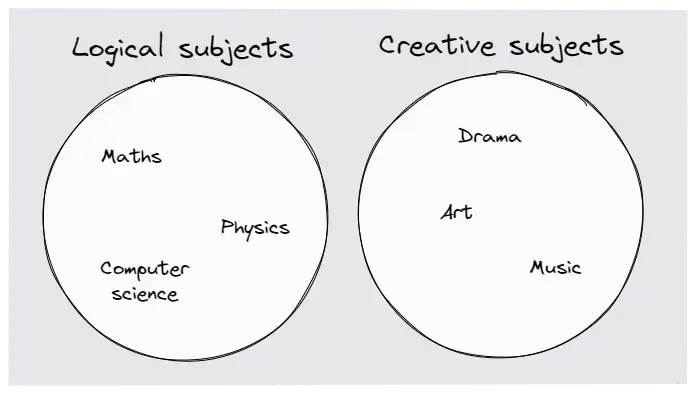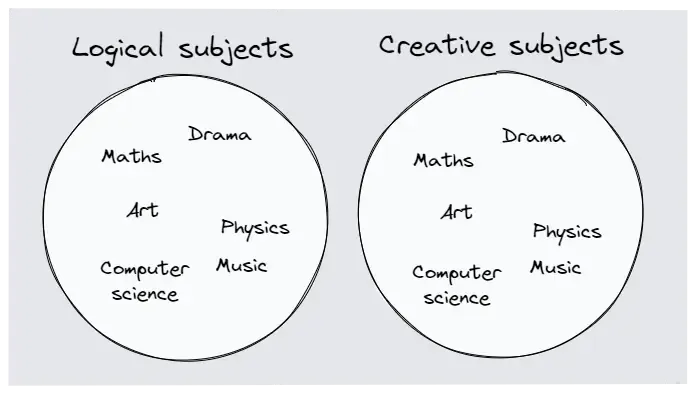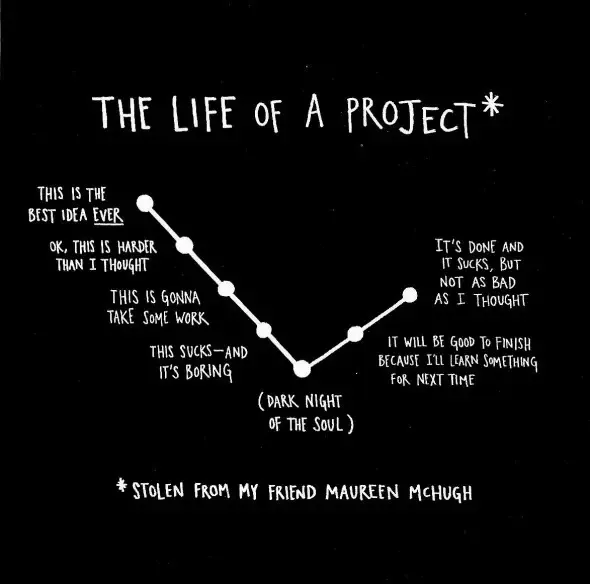I used to think I wasn’t a creative person.
During high school, I thought there were “logical” subjects (like maths and science), and “creative” subjects (like art and music). My favourite subjects were maths and science, so I concluded I just wasn’t a creative person.

Now I see that view as naïve. Problem-solving involves logic and creativity.
Writing blog posts has forced me to embrace creativity. Logic alone cannot create an interesting article, even for heavily logical topics.

This epiphany, though, still left me with a question: “Can creativity be learned, or is it a natural talent that only a lucky few are born with?”
After I heard it being recommended by several people, I picked up Steal Like an Artist. It’s a book targeted to anyone who’s “trying to inject some creativity into their life and their work.” Given that creativity is increasingly important, this should apply to pretty much everyone.
What The Book Is About
Steal Like an Artist is a book full of advice for people trying to do acts of creativity. It addresses questions like:
- What should I write about? Everything’s already been done.
- How can I be as good as my heroes?
- Why isn’t my creation as good as I pictured it would be?
- How do I get other people to see the work I’ve done?
The book is just advice. It doesn’t claim that every piece of advice will work for everyone (“Your mileage may vary!”). The invitation is to take the flecks of gold that apply to you and feel free to leave the rest.
Everything’s already been done
“Nothing is original.”
Writer Jonathan Lethem remarked that when people call something “original,” nine out of ten times they just don’t know the references or the original sources involved.
That feeling - that everything had already been written - fought against me as I wrote one of my first blog posts. It was just after React hooks had been announced and I had been consuming all I could to learn about them.
I wanted to write a blog post about them, but I didn’t know what to say - after all, everything I knew had come from somewhere else, so if someone wanted to know what I knew, they just had to look at all the things I had looked at.
Despite this, I pooled together my favourite sources and write By the Hook: A Practical Introduction to React Hooks. To my surprise it remains one of my most popular blog posts, but the lesson I learned from it was that we shouldn’t be afraid to repeat what has already been said.
“Everything that needs to be said has already been said. But, since no one was listening, everything must be said again.” - André Gide
Once we accept that nothing is original, we are freed from the burden of needing to be original. Instead of avoiding influence, we welcome it. And once we embrace it, we can start finding connections that can spark us to create something unique.
Stealing vs Copying
Once we accept that nothing is original, the question becomes, “How do we accept influence from other sources, without copying them?”
In a letter to his rival, Sir Isaac Newton wrote, “If I have seen further it is by standing on the shoulders of giants.” The lesson is that we should find giants, stand on their shoulders, and try to see further than they were able to.
Finding Giants Worth Standing On
The people we surround ourselves with influence us more than we realise. Motivational speaker Jim Rohn claimed that we are the average of the five people we spend the most time with. We need to actively seek out the best in the fields we pursue and surround ourselves with them. Follow them on social media, see what they’re working on, and learn what makes them so good.
As Austin Kleon puts it, “If you ever find that you’re the most talented person in the room, you need to find another room.”
Standing on Shoulders
Austin Kleon says we should copy our heroes, but only to learn about the thought process behind their creations. It’s like taking something apart to understand how it works.
A common piece of advice to those trying to be better at software development is to choose an open-source project and try and implement it yourself. Only refer to the existing code when you’re too stuck to continue. Once you’ve finished, compare what you did with the original code. What differences are there between them? Why did the original author choose to implement it the way they did?
Similarly, a common piece of advice for those learning chess is to watch historical games, such as the Opera game. For each move, ask yourself, why did the player make that move? What is the principle that can be learned here?
“You don’t want to look like your heroes, you want to see like your heroes” - Austin Kleon.
Seeing Further Than Giants
Once we have learned from other masters, our goal is to move beyond them - to create something new.
It’s easier said than done. How do we embrace influence without plagiarism?
When I was in high school, I studied music. For one of the assignments, we had to choose a genre of music, choose a piece of music from that genre, explain how it fitted into that genre, and then compose a song in that genre.
I struggled to create my piece - whenever I was stuck, I would turn to the original song I had chosen and basically copied what that song did. As you can imagine, the result was terrible. It was essentially a worse version of the original song.
The easiest way to avoid this problem is to use multiple sources of inspiration. This allows us to mix them into something new and prevents us from creating a replica of a single piece of work.
What Should You Make?
When you are at the start, it can be hard to know what to make. How can you write about something if you don’t even know what to write about?
Austin Kleon says that that’s backwards: it’s through making things and doing our work that we discover who we are.
So instead of waiting to find your passion before you start, just start making things. Write blog posts that you want to read. Create YouTube videos you would want to watch. Make the change you want to see in the world. In short, “do the work you want to see done.”
Start random side projects and hobbies that have nothing to do with the other things you’re working on. Don’t worry about having a grand plan. Just create, create, create.
Why Does My Creation Suck?
Steal Like an Artist includes a chart of “The Life of a Project,” and I’ve never seen anything so perfectly describe the thought process of each of my blog posts (including this one)!

So how do we get through the “dark night of the soul” to “It’s done and it sucks, but not as bad as I thought”?
Fake It ‘Til You Make It.
Austin Kleon points out that “fake it ‘til you make it” has two meanings.
- It’s through pretending to be something - pushing through the impostor syndrome and doing the work anyway - that we become the thing we want to be.
- It’s through pretending to make something that we eventually make it. It’s through doing that we actually improve, so even if our creation isn’t as good as we wanted it to be now, no effort is wasted. At the very least there will be lessons learned and skills refined.
At the end of the day, nothing is perfect. But it’s those who do it anyway that make a difference in the world, not those who are waiting for perfection to strike them first.
“Modern art = I could do that + Yeah, but you didn’t.” - Craig Damrauer
Sharing Your Work
The Secret is to do good work and then share it with people.
Step one is what we’ve talked about so far. It’s hard and time-consuming. If it was easy, everyone would be doing it and there would be no value in it.
Step two - sharing it with others - is still hard, but it’s easier now than it’s ever been before. With the internet, we can show our work and build a community of people working on similar problems. This is covered more in another of Austin Kleon’s books, Show your Work!, so I’ll save the details for another post.
However, weren’t we just talking about how our current creations suck and are boring?
In the beginning, obscurity isn’t a case to escape from, it’s freedom. Freedom to create whatever we want without any judgement. Freedom to try new things. Freedom to practice.
Once this freedom is lost, it’s gone for good. Take advantage of it while it lasts.
How to Make Time For Creativity
At each stage of my life, I seem to look back and think “Man, I had so much free time back in the day. If only I used it productively, imagine what my life could be like now!”
We never seem to have enough time to do all the things worth doing. But this doesn’t mean we shouldn’t do them.
We need to find ways of stealing small snippets of time and putting them to use. The easiest way to do this is by establishing a routine. Small, consistent efforts over a long time can yield greater fruits than inconsistent marathons.
Parkinson’s Law has a Stock–Sanford corollary: “If you wait until the last minute, it only takes a minute to do.” Deadlines have a habit of focusing us on what is important and encourages us to think of creative shortcuts that we may have otherwise missed.
Unfortunately, the boring solutions are the best way to get things done. If we want to focus on our work, we need to free our minds from other stresses that will inevitably invade if left unattended. Learn about personal finance and keep a budget. Write down a to-do list. Ironically, order is the parent of creativity, not chaos.